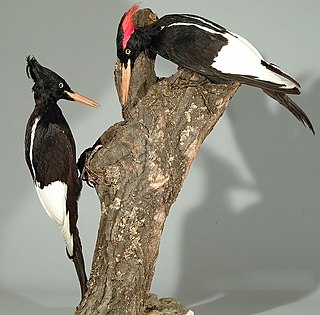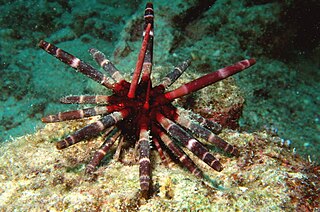
An echinoderm is any deuterostomal animal of the phylum Echinodermata, which includes starfish, brittle stars, sea urchins, sand dollars and sea cucumbers, as well as the sessile sea lilies or "stone lilies". While bilaterally symmetrical as larvae, as adults echinoderms are recognisable by their usually five-pointed radial symmetry, and are found on the sea bed at every ocean depth from the intertidal zone to the abyssal zone. The phylum contains about 7,600 living species, making it the second-largest group of deuterostomes after the chordates, as well as the largest marine-only phylum. The first definitive echinoderms appeared near the start of the Cambrian.

Sea urchins or urchins are typically spiny, globular animals, echinoderms in the class Echinoidea. About 950 species live on the seabed, inhabiting all oceans and depth zones from the intertidal to 5,000 metres. Their tests are round and spiny, typically from 3 to 10 cm across. Sea urchins move slowly, crawling with their tube feet, and sometimes pushing themselves with their spines. They feed primarily on algae but also eat slow-moving or sessile animals. Their predators include sea otters, starfish, wolf eels, and triggerfish.

Fritillaria imperialis, the crown imperial, imperial fritillary, Kaiser's crown, or Kurdish tulip is a species of flowering plant in the lily family Liliaceae, native to a wide stretch from the Anatolian plateau of Turkey, Iraq and Iran to Afghanistan, Pakistan, Northern India and the Himalayan foothills. It is also widely cultivated as an ornamental and reportedly naturalized in Austria, Sicily, and Washington State, USA. The common names and also the epithet "imperialis", literally "of the emperor", refer to the large circle of golden flowers, reminiscent of an emperor's crown.

The imperial woodpecker is a woodpecker species endemic to Mexico. If it is not extinct, it is the world's largest woodpecker species, at 56–60 cm (22–23.5 in) long. Researchers have discovered that the imperial woodpecker has slow climbing strides and a fast wing-flap rate compared with other woodpeckers. Owing to its close taxonomic relationship, and its similarity in appearance, to the ivory-billed woodpecker, it is sometimes called the Mexican ivory-billed woodpecker, but this name is also used for the extant pale-billed woodpecker. The large and conspicuous bird has long been known to the native inhabitants of Mexico and was called cuauhtotomomi in Nahuatl, uagam by the Tepehuán and cumecócari by the Tarahumara.

The gallopheasants are pheasants of the family Phasianidae. The genus comprises 11 species and several subspecies. Several species in this genus are known as firebacks, including crestless and crested firebacks, as well as the Siamese fireback.

The imperial amazon or Dominican amazon, also known as the sisserou or sisserou parrot, is a parrot found only on the Caribbean island of Dominica. It has been designated as the national bird of Dominica, and features on the national flag of Dominica. The species is critically endangered. In 2019, it was estimated there were only about 50 mature individuals left in the wild.

In biology, a test is the hard shell of some spherical marine animals and protists, notably sea urchins and microorganisms such as testate foraminiferans, radiolarians, and testate amoebae. The term is also applied to the covering of scale insects. The related Latin term testa is used for the hard seed coat of plant seeds.

The imperial cave salamander, imperial salamander, odorous cave salamander, or scented cave salamander is a species of salamander in the family Plethodontidae. It is endemic to Sardinia.

Strongylocentrotus droebachiensis is commonly known as the green sea urchin because of its characteristic green color, not to be confused with Psammechinus miliaris as it is also commonly called the green sea urchin. It is commonly found in northern waters all around the world including both the Pacific and Atlantic Oceans to a northerly latitude of 81 degrees and as far south as Maine and England. The average adult size is around 50 mm (2 in), but it has been recorded at a diameter of 87 mm (3.4 in). The green sea urchin prefers to eat seaweeds but will eat other organisms. They are eaten by a variety of predators, including sea stars, crabs, large fish, mammals, birds, and humans. The species name "droebachiensis" is derived from the name of the town Drøbak in Norway.

Heterocentrotus mamillatus, commonly known as the slate pencil urchin, red slate pencil urchin, or red pencil urchin, is a species of tropical sea urchin from the Indo-Pacific region.

Cidaroida, also known as pencil urchins, is an order of primitive sea urchins, the only living order of the subclass Perischoechinoidea. All other orders of this subclass, which were even more primitive than the living forms, became extinct during the Mesozoic.

Strigatella imperialis is a species of sea snail, a marine gastropod mollusk in the family Mitridae, the miters or miter snails.

Cymbiola imperialis, the imperial volute, is a species of sea snail, a marine gastropod mollusk of the genus Cymbiola in the family Volutidae, the volutes.

Cidaridae is a family of sea urchins in the order Cidaroida.

Heterocentrotus is a genus of the familia Echinometridae. They are mainly found in the Indo-Pacific basin, especially in Reunion or Hawaii. This genus appeared in the Miocene and spread throughout the warm Indo-Pacific.

Phyllacanthus is a genus of echinoderms belonging to the family Cidaridae.

Stylocidaris affinis, also known as pencil urchin or red lance urchin, is a species of sea urchin.

Pseudoboletia indiana, commonly known as the pebble collector urchin, is a species of echinoderms belonging to the family Taxopneustidae. In Hawaii P. indiana is also known as hawa`e po`ohina.


















